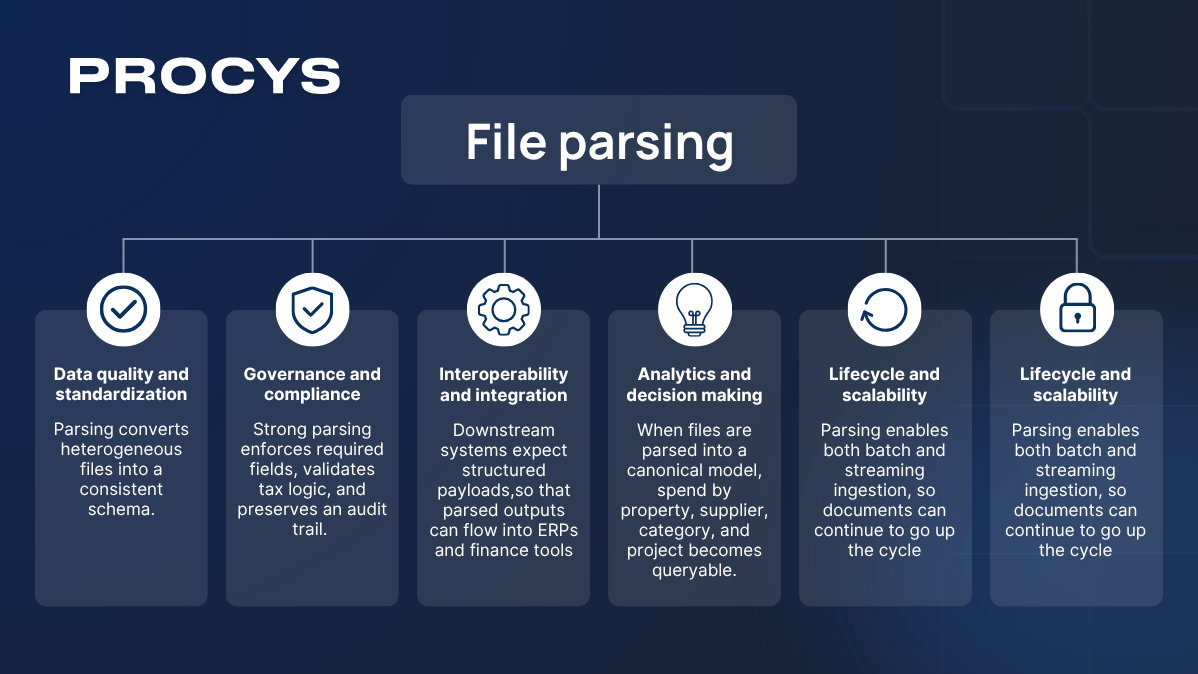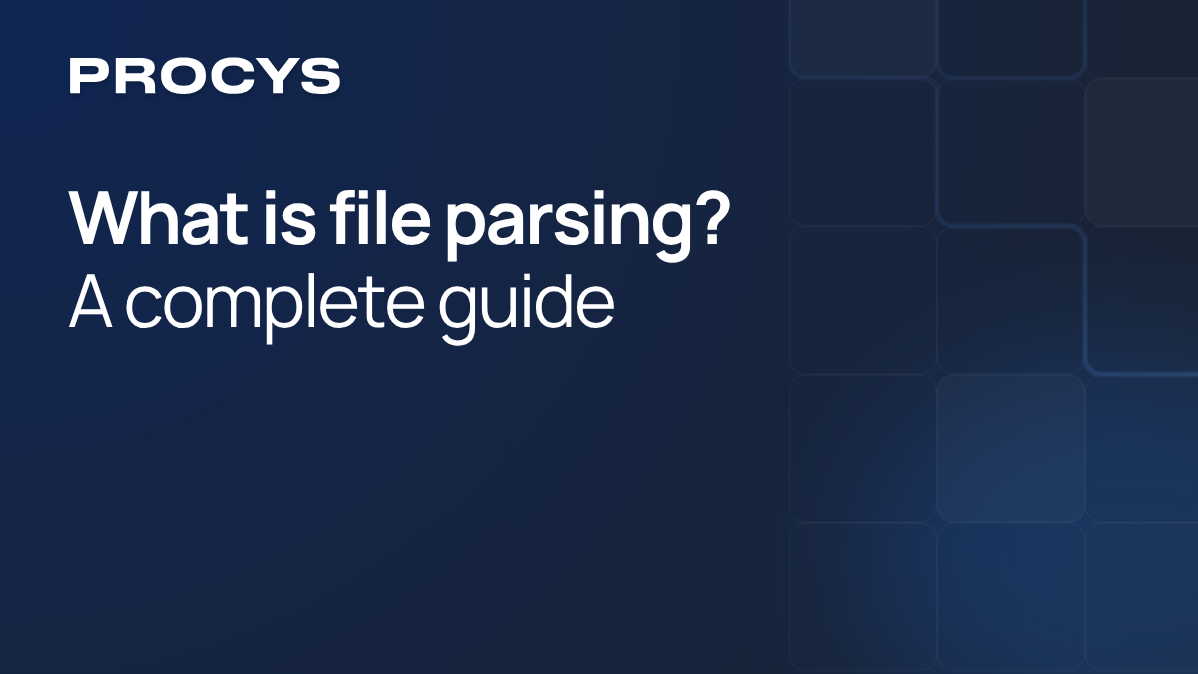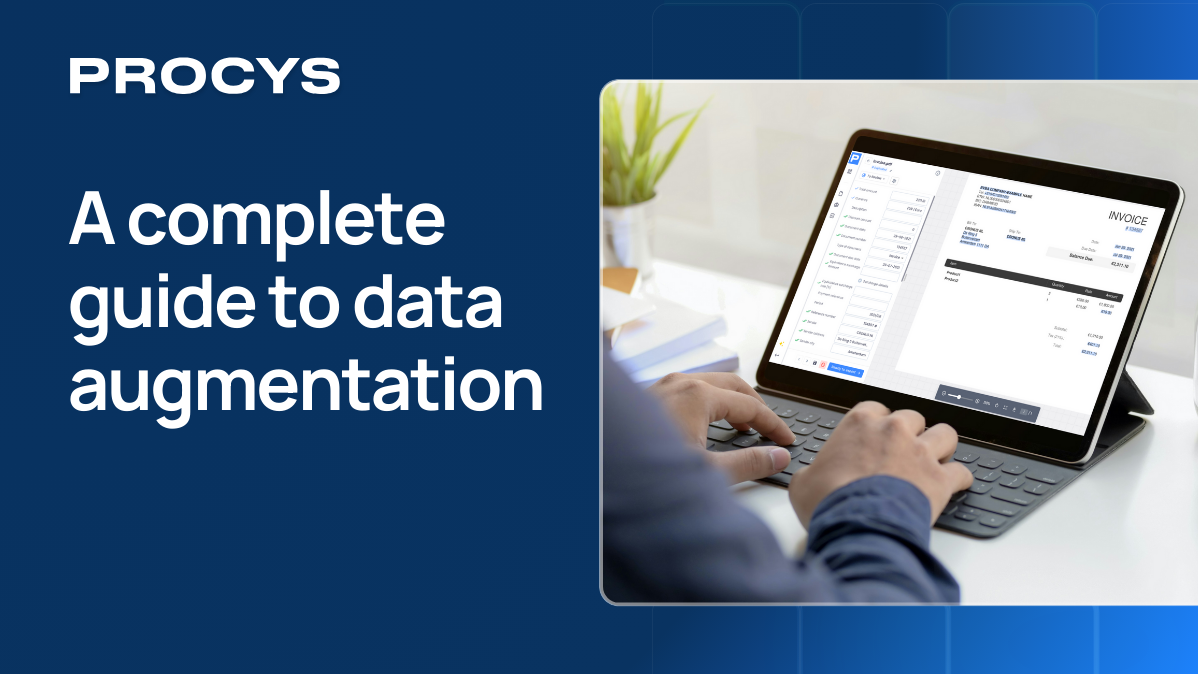Modern business operations run on data, but much of that data arrives in unstructured formats like PDFs, scanned documents, emails, CSVs, or XMLs.
These formats aren’t readily usable for automation, analysis, or compliance workflows, which creates bottlenecks and inefficiencies. This is where file parsing becomes essential.
From financial institutions processing thousands of invoices per day to tax advisors organizing client reports to hospitality chains managing vendor contracts, the ability to turn unstructured files into structured, usable data is now a fundamental requirement.
In this guide, we break down what file parsing is, how it works, and how it empowers organizations to improve accuracy, efficiency, and compliance.
Roles like CFOs looking to optimize AP workflows or IT leaders integrating data flows across systems should have at least a general idea of why file parsing is key to enabling automation at scale - Procys has you covered.
What is file parsing?
File parsing is the process of analyzing a file’s content and structure automatically to extract relevant information based on specific rules and formats.
Put simply, when you parse a file, you convert data from a raw, often human-readable format like a PDF or email into a machine-readable structure such as JSON, XML, or a database entry. This allows automation tools, analytics platforms, and business applications to understand, process, and act on the data inside the file.
How parsing differs from data extraction
Although often used interchangeably, file parsing and data extraction serve different purposes.
Data extraction pulls out predefined fields, for example the invoice total or due date, using OCR or manual rules. Parsing goes deeper, interpreting the structure of the entire document. It identifies sections, hierarchies, relationships, and context, then transforms the content into structured data using logic and validations.
Think of data extraction as copying information, while parsing involves understanding and organizing it for downstream use.
The need for file parsing across industries
Organizations fill the gap between how documents arrive and how systems expect data, accounting firms and hospitality groups are two of the clearest examples
Accounting and tax
When accounting firms juggle invoices, receipts, bank statements, payroll reports, tax forms, and client communications, they can use file parsing.
Being the documents PDFs or scans, that allows accounting teams to avoid spending hours in manual tasks like:
- Rekeying figures
- Reconciling mismatches
- Chasing missing fields
So to not delay month end and tax filings, and protect them from compliance risk.
With parsing, unstructured inputs become structured records, so tools can validate amounts, dates, VAT or sales tax ids, and GL codes automatically.
In a typical AP and AR cycle, this affects supplier invoices and receipts to extract header and line items, taxes, and payment terms, normalizing client documents to a standard schema for working papers and other tools.
Advanced systems allow integrations with accounting software like QuickBooks, Exact, FreshBooks, Microsoft Business Central and much more.
Ultimately, file parsing is the foundation that makes downstream automation reliable and auditable for decision makers like CFOs, finance managers, and accounting professionals.
Parsing files in hospitality
Hotel groups, restaurant chains, and travel operators process a high volume of vendor invoices, purchase orders, delivery notes, and folios.
These documents often come from fragmented systems and arrive in mixed formats. Without parsing, finance teams reconcile data by hand across PMS, POS, inventory, and accounting.
The result is delay, stock discrepancies, and payment errors: file parsing standardizes multi-format documents from suppliers, utilities, and agencies into a consistent data model.
That consistency enables:
- Automatic three-way checks between PO
- Delivery note and invoice automations
- Price and quantity validation, with clean routing for approval
In other words, prioritizing guest experience and cost control means also relying on functions like this to feed clean, structured data into existing systems and workflows.
When in pair with external tools like ERPs, CRMs, automation and accounting systems, parsing generates a positive ripple effect to relate core data with business information like suppliers and customer specifics.
The role of file parsing in data management
File parsing is the bridge between messy inputs and governed, usable data. It sits at the start of your data pipeline and affects quality, compliance, analytics, and automation across the stack.
Here’s file parsing role in data management.

Data quality and standardization
Parsing converts heterogeneous files into a consistent schema.
Governance and compliance
Strong parsing enforces required fields, validates tax logic, and preserves an audit trail.
Interoperability and integration
Downstream systems expect structured payloads,so that parsed outputs can flow into ERPs and finance tools
Analytics and decision making
When files are parsed into a canonical model, spend by property, supplier, category, and project becomes queryable.
Lifecycle and scalability
Parsing enables both batch and streaming ingestion, so documents can continue to go up the cycle
Security and privacy
Parsing is also about selective extraction, where advanced set ups can create rules to not extract sensitive information. Also, it must be part of a secure infrastructure that protects data flows.
How file parsing works, techniques and best practices
File parsing converts messy inputs into clean, structured data that systems can trust.
The flow typically includes ingestion, detection, extraction, validation, enrichment, and delivery to downstream apps, for example accounting software or workflow tools.
Ingestion and format detection
The system first captures files from emails, cloud storage, SFTP, or APIs, while detecting the file type and encoding.
Then, it normalizes the input for consistent handling.
Structure understanding
Before extracting fields, the file parsing software maps the document layout, identifying headers, tables, key value blocks, and footers.
For business docs like invoices, it recognizes repeated line items versus single value headers.
Core extraction strategies
Different extraction techniques are more suitable for different scenarios and types of documents. Thus, custom data extraction systems cover a wide area of use cases, also exploiting NLP and ML to function.
Human in the loop
Personalization and precision can also be about involving people in the parsing process.
Here, a great characteristic to look for is a tool’s ability to learn from corrections and feed that knowledge into templates or models.
Human intervention is also useful at the moment of tracking and trailing operations.
Delivery and integrations
Outputting structured data in various formats, like JSON, XML, or CSV, is a matter of flexibility.
Advanced Intelligent Document Processing software can work with custom APIs or pre-built integrations to ensure maximum agility depending on specific business needs.
Best practices example for accounting workflows
Parse supplier invoices, extract header fields and line items and validate totals and taxes.
Then, the team can upload on the company’s accounting tools: the result is faster month end close and fewer posting errors.
Best practices example for hospitality
To reduce invoice cycle time and improve vendor relationships, parse delivery notes and invoices from food and beverage vendors, detect tables, run price and run quantity checks against POs.
Use file parsing to flag discrepancies, and route exceptions for property level approval into a management software.
Challenges and solutions in file parsing
File parsing is not always streamlined: advanced parsing systems tackle major challenges to help non-technical teams work smoothly without spending big budgets on on-prem solutions.
Data variability
Challenge
Vendors, clients, and partners use different templates, languages, and file types, which breaks brittle parsers.
Solution
Systems like Procys combine ML based layout detection with light vendor rules, while adopting a canonical schema and mapping sources to it.
Low-quality scans and OCR noise
Challenge
Scanned PDFs, skewed images, and faded prints degrade recognition, causing bad dates, totals, or tax IDs.
Solution
The best OCR software apply techniques like image pre-processing, de-skew, de-noise, and more to reduce recognition errors to a minimum.
Ambiguous structures and tables
Challenge
Complex tables, multi line descriptions, and mixed values confuse simplistic extractors.
Solution
The best data extraction systems normalize values and apply automated data structuring so numbers and information are kept intact.
Integration gaps
Challenge
Structured data is useful only if it can reach other systems like ERPs, accounting tools, and workflow apps reliably.
Solution
Overloading small and medium businesses with custom integrations is a thing of the past.
Advanced file parsing systems like Procys offer pre-built integrations with major tools, while still including enterprise-grade solutions.
Compliance and auditability
Challenge
Incorrect tax logic, missing fields, or weak traceability create audit risk for EU-heavy operations.
Solution
Platforms that work with data need to offer top security level to protect data in transit and at rest, while complying with local privacy regulations. Procys is ISO 27001-compliant with tools officially approved by the Spanish Tax Agency (AEAT), like the invoice data extraction software.
Conclusion
File parsing turns unstructured files into governed, usable data, it improves accuracy, speeds approvals, and strengthens compliance across industries like accounting and hospitality.
If you work with complex or voluminous documents and are looking for maximum precision and faster processing, try Procys for free.





.png)